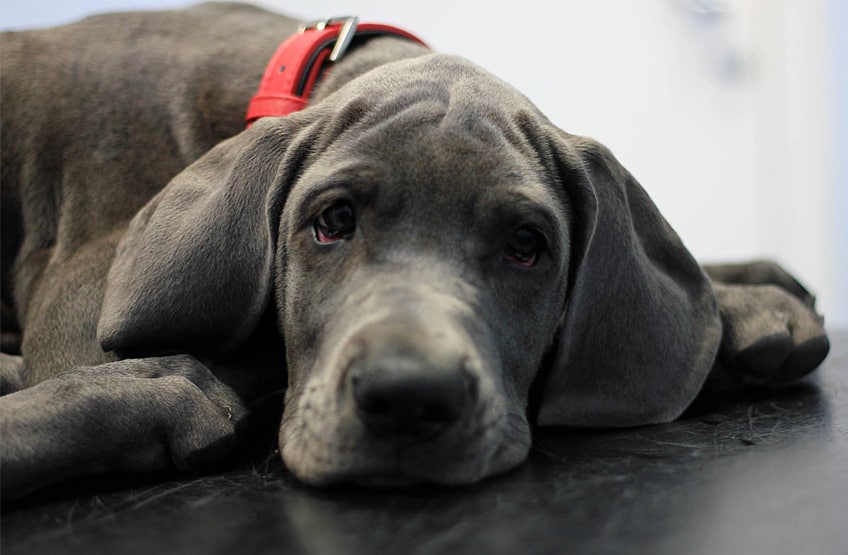Learning about your dog's behaviour is a key element in building a strong relationship, which will allow you to understand how your dog is feeling, or why they behave in certain ways.
Your dog's behaviour
Dog behaviour is something we often get asked for help and advice for here at Calder Vets. This pet advice article will provide you with lots of information when it comes to your dog’s behaviour, to help you and your dog understand each other better, which is an important aspect of building a good relationship.
Building good relationships
Just as between people, great relationships between dogs and their owners are based on good communication. Dogs communicate between themselves by means of body signals. It’s only natural, then, that they’ll use the same method to communicate with people.
Your job as a pet owner is to learn to interpret such signals. Doing so will enable you to teach your puppy or dog the appropriate way of telling you what he or she needs or would like, whether its food, to be let out, to play or to receive some loving attention from you.
Never punish a growl! Dogs use lots of subtle body signals before they growl, to tell us when they are feeling threatened or uncomfortable, and it’s vital we learn to understand them and give a dog appropriate space when they show them. Sometimes however we may miss these smaller signals and a dog may then resort to growling as the smaller signals didn’t work. If you punish the growl you run the risk that your dog will still feel uncomfortable, however as none of the more subtle signals have worked, your dog may then go straight to biting seemingly “out of the blue” as it’s last method of defense.
If your dog is showing aggressive behaviour please contact a reputable behaviourist for help.
Social skills aren't just for humans!
One of the most useful things your puppy or dog can learn is to sit before interacting with you or anyone else. This helps prevent jumping up and teaches your dog a polite way to greet people. You can easily teach a puppy or even a mature dog to sit. Dogs learn at any age, as long as lessons are repeated often enough and teaching sessions are short and fun.
Step 1
To begin, take a small food treat, like a small piece of cheese, and hold it between two fingers. Place this hand close to the front of your pets nose.
Step 2
Raise the hand above his/her nose and then backwards. Your pets head will move to follow the treat. Eventually your dog will sit because it will be more comfortable.
Step 3
As soon as this is done say “sit” and give your pet the treat. As a dog always connects what they are saying with what you are doing at the same time, they'll associate the action of sitting with the word “sit” and a reward.
Good behaviour should be rewarded
It can be easy to forget to praise good behaviour and find we sometimes ignore them when they are quiet and well behaved and pay them attention when they behaved inappropriately. It’s always best to remember to do the reverse and praise and reward a desired behaviour and ignore the unwanted. It’s far easier and creates a much stronger bond between us and our pets if we teach them what we do want them to do, rather than tell them off for doing what we don’t want.
For safety reasons you must interrupt dangerous behaviour such as chewing inappropriate items.
How to deal with unwanted behaviour?
First, work out why it's happening
If the behaviour is due to fear or anxiety this needs to be addressed first before trying to teach your dog something else.
Then, stop reinforcing it and teach an alternative. For example; Dogs, just like humans, are social animals and usually crave interaction with us. Because of this, when a dog jumps up to greet people, they find it very reinforcing as it almost always will result in some kind of interaction with the person (laughing, stroking or just talking to them), and this will therefore be very rewarding to the dog.
To try and change this behaviour, first stop rewarding the unwanted behaviour - so in the case of jumping up don’t respond, don’t touch, talk or even tell off your dog as this could all be seen as rewarding depending on your dog. You may need to turn your back or take a step backwards to encourage them to get down.
As soon as your dog’s feet are on the floor, praise them and throw a treat away from you for them to have as a reward.
Then when they come back ask them for a sit before they get to you so they don’t have the opportunity to jump up, and immediately reward them when they do this. Since your dog cannot jump up and sit at the same time, your dog will soon decide that sitting is far more fun than jumping up.
If, in the past, you allowed your puppy or dog to gain your attention by barking or jumping up on you, this behaviour will be harder to change. However, if you and everyone else who interacts with your dog are consistent, and persevere, there is no reason why you can’t change this behaviour.
Teaching your dog to focus on you
Call your puppy or dog by his/her name. As soon as they look at you, you should give them a special treat. Repeating this simple exercise in lots of different situations will teach your pet that it is worthwhile to pay attention to you no matter what is going on around them.
In fact, calling your pet’s name can be a nice way of interrupting unwanted behaviour. It should give you just long enough for you to then ask them for something else, like a sit or hand touch, that they can earn a tasty treat or a game of tug for. This should help take their mind off whatever they were doing previously and get their focus back on you.
Dogs, just like humans, are social animals and need interaction with others, so withholding your attention is a very effective way of teaching your dog that there are better ways to get the attention they crave.
If you have any questions about your dogs behaviour, call your local Calder Vets branch. We're here to help.



Our Services